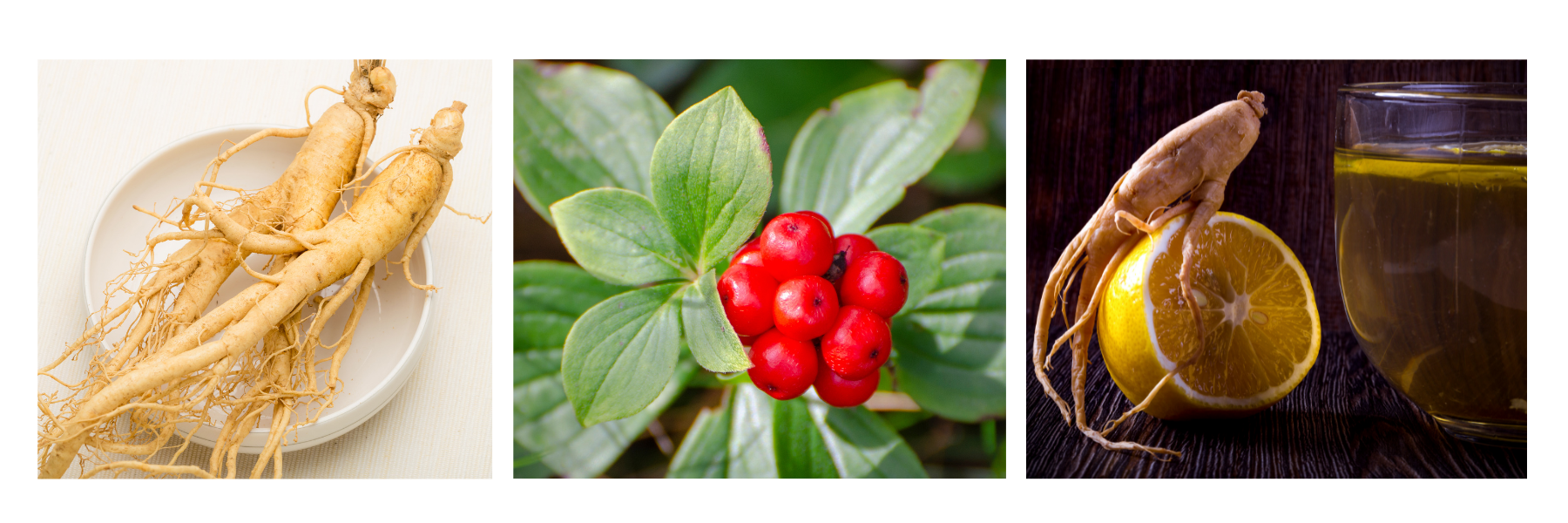White Ginseng Root – The Power Of A Single Root
(To view all forms of Ginseng see our product page)
This herb White Ginseng Root has been used for centuries. Let’s explore the reason why.

What Is White Ginseng
White Ginseng belongs to the Araliaceae plant family.
Medicinal Properties Of White Ginseng
White Ginseng Root primary advantages include:
1. Endurance and Stamina: White ginseng is known for its adaptogenic properties that support physical endurance. Recent research show that it may help with mental fatigue as well. It can help combat fatigue and increase overall energy levels.
2. Enhancing cognitive function: Regular consumption of white ginseng may improve focus, memory, and concentration. It has been traditionally used to support brain health and mental clarity.
3. Strengthening the immune system: White ginseng possesses immune-boosting properties, helping to enhance the body's natural defense mechanisms. It may help reduce the risk of infections and improve overall immune system function.
4. Supporting stress management: White ginseng is believed to have stress-relieving and mood-enhancing properties. It can help combat the negative effects of stress and promote a sense of overall well-being.
5. Promoting cardiovascular health: Studies have shown that white ginseng may help lower blood pressure, reduce cholesterol levels, and improve heart health. It may also support healthy blood circulation.
6. Anti-inflammatory effects: White ginseng contains compounds with potential anti-inflammatory properties. It may help alleviate inflammation in the body and reduce related symptoms.
7. Supporting healthy aging: White ginseng is rich in antioxidants, which help protect against free radicals and oxidative stress. Regular consumption may contribute to healthy aging and overall longevity.
This plant includes multiple bioactive compounds that play a role in its positive outcomes
Let's examine the main active compounds found in White Ginseng Root:
White ginseng root contains several active components, including:
Ginsenosides: These are the main bioactive compounds in ginseng. Ginsenosides are believed to be responsible for many of the health benefits associated with ginseng, including its adaptogenic, immune-modulating, and cognitive-enhancing effects.
Polyacetylenes: These compounds have anti-inflammatory properties and may contribute to the immune-boosting effects of white ginseng.
Polysaccharides: White ginseng also contains polysaccharides, which have antioxidant and immune-enhancing properties.
Panaxydol: This compound has been found to have anticancer and antioxidant effects.
Panaxadiol: It is a triterpene compound that exhibits various biological activities, including anti-inflammatory and antitumor effects.
Panaxatriol: Another triterpene compound with potential anti-inflammatory and antioxidant properties. These active components work together to contribute to the medicinal properties of white ginseng, but it's important to note that the composition and concentration of these components can vary depending on factors such as the ginseng's age, cultivation conditions, and processing methods.
Four Of The Most Asked Questions About White Ginseng Root
1. What are the health benefits of white ginseng?
White ginseng offers numerous benefits, including boosting energy, enhancing cognitive function, strengthening the immune system, supporting stress management, promoting cardiovascular health, and exhibiting anti-inflammatory effects.
2. How does white ginseng differ from red ginseng?
White ginseng is made from dried ginseng root without any additional processing, while red ginseng undergoes a steaming and drying process. This process enhances certain properties of the ginseng, resulting in differences in taste, composition, and potential health benefits.
3. How to consume white ginseng?
White ginseng can be consumed in various forms, including capsules, powder, tea, or as an ingredient in food or beverages. The appropriate dosage and form of consumption may vary depending on individual preferences and health conditions.
4. Are there any side effects or precautions of using white ginseng?
While white ginseng is generally safe for most people when used in moderation, some individuals may experience side effects such as digestive issues, insomnia, or allergic reactions. It is important to consult a healthcare professional before starting any new supplements, especially if you have underlying health conditions or are taking medications.

What are some popular recipes using White Ginseng Root?
White Ginseng Tea:
Ingredients:
- 1-2 slices of dried white ginseng root
- 2 cups of water
- Honey or sweetener (optional)
- Instructions:
In a small pot, add water and white ginseng root slices.
Bring the water to a boil and let it simmer for about 20-30 minutes.
Remove from heat and strain the tea.
If desired, add honey or any sweetener to taste.
Enjoy the warm tea and reap the benefits of white ginseng.
Soak the white ginseng root slices in warm water for about
20-30 minutes to soften them.
Peel and chop the banana into chunks.
In a blender, combine the soaked ginseng root slices, banana, berries, almond milk,
and honey/sweetener.
Blend until smooth and creamy.
If desired, add some ice cubes and blend again to make it colder.
Pour into a glass or jar, and enjoy a refreshing white ginseng smoothie.
Ginseng Soup:
- Ingredients:
- White ginseng root slices
- Chicken or vegetable broth
- Sliced chicken or tofu
- Sliced shiitake mushrooms
- Sliced carrots
- Sliced ginger
- Salt and pepper to taste
- Instructions:
and bring to a simmer.
Add the chicken or tofu, shiitake mushrooms, and carrots.
Simmer until the ingredients are cooked through.
Season with salt and pepper to taste. Serve as a hearty soup.
Ginseng Stir-Fry:
- Ingredients:
- White ginseng root slices
- Sliced chicken, tofu, or shrimp
- Assorted vegetables (bell peppers, broccoli, carrots, etc.)
- Soy sauce or teriyaki sauce
- Garlic and ginger, minced
- Cooking oil
- Instructions:
Add your choice of protein and vegetables, then stir-fry until cooked.
Ginseng Infused Honey:
- Ingredients:
- White ginseng root slices
- Honey
- Instructions:
Allow the honey to infuse with the ginseng for a few weeks, shaking the jar occasionally.
Use this ginseng-infused honey as a sweetener for tea, yogurt, or desserts.
Remember to adjust the quantities and ingredients to suit your taste preferences
HISTORICAL USE OF WHITE GINSENG ROOT
White ginseng (Panax ginseng) is a valuable herb with a long history of use in traditional medicine, particularly in Asian countries. Here is an overview of the history of white ginseng:
2. Chinese Medicine: In traditional Chinese medicine, ginseng is classified as an adaptogen, an herb that helps the body adapt to stress and maintain balance. It was believed to boost energy, improve mental clarity, and enhance vitality.
3. Korean Ginseng: Ginseng is also known as "Ren Shen" in Chinese and "Insam" in Korean. Korean ginseng (Panax ginseng) is one of the most famous and highly regarded types of ginseng. White ginseng is essentially the same plant as Korean red ginseng but processed differently.
4. Processing into White Ginseng: White ginseng is made by air-drying the ginseng root after harvesting, which gives it a pale or white appearance. The drying process can take several weeks. This is in contrast to Korean red ginseng, which is steamed before drying, giving it a reddish color. The drying process alters the chemical composition of the ginsenosides, the active compounds in ginseng.
5. Ginseng in Traditional Medicine: Throughout history, ginseng was used to treat a wide range of ailments, such as fatigue, stress, inflammation, and cognitive issues. It was also considered an aphrodisiac and used to enhance libido.
6. Ginseng in North America: Native Americans in North America also had their own variety of ginseng, American ginseng (Panax quinquefolius), which they used for its potential medicinal properties. American ginseng has different chemical properties and uses compared to Asian ginseng.
7. Modern Research: In the 20th and 21st centuries, ginseng, including white ginseng, has garnered significant interest from researchers. Numerous studies have explored its potential health benefits, including its adaptogenic properties, effects on energy and cognitive function, and its potential as a natural remedy for various health issues.
8. Cultivation and Trade: The cultivation of ginseng, both Asian and American varieties, became a significant industry. Ginseng is grown in several countries, with China, South Korea, Canada, and the United States being some of the largest producers.
Today, white ginseng remains an essential component of traditional and herbal medicine, and its popularity continues to grow worldwide. While many of its traditional uses have been supported by scientific research, ginseng's effects can vary from person to person, and it's important to consult with a healthcare professional before using it for specific health concerns.
White ginseng, known by its scientific name Panax ginseng, may have various regional and common names. Here are different names for white ginseng:
2. Ren Shen: This is the Chinese name for white ginseng, and it's commonly used in traditional Chinese medicine.
3. Insam: In Korean, "Insam" is a common term for white ginseng, as well as other types of ginseng.
4. Bai Shen: In Chinese, "Bai Shen" is often used to refer to white ginseng. "Bai" means white.
5. White Panax Ginseng: Some products and supplements use this straightforward name to indicate that they are made from white ginseng.
6. Asian Ginseng: White ginseng is a type of Asian ginseng, which is a more general term that can refer to various types and preparations of ginseng.
7. Korean Ginseng Root: In herbal and health food products, it may be labeled as "Korean ginseng root" to denote its origin.
8. Ginseng Radix Alba: This is the Latin botanical name for white ginseng and may be used in scientific and herbal contexts.
These names may vary depending on the region and language, but they all refer to the same plant, Panax ginseng, processed in a way that results in a pale or white appearance.
